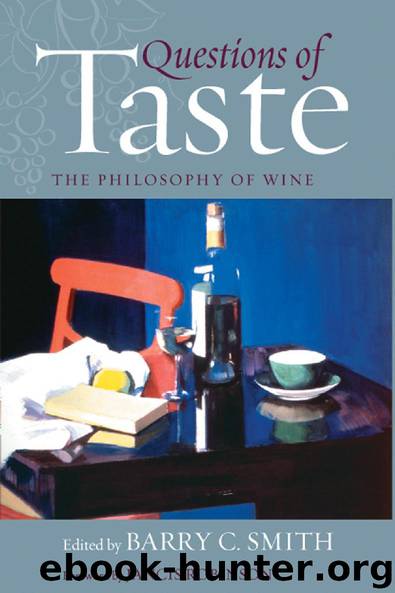Questions of Taste by Barry C Smith

Author:Barry C Smith
Language: eng
Format: epub
Tags: Beverages, Wine, Philosophy, History of Philosophy
ISBN: 9781908493422
Publisher: Andrews UK Limited 2013
Published: 2013-02-05T00:00:00+00:00
One may then say that this is a problem for theoretical chemistry, not for wine tasting and wine chemistry. From the presence of the vanilla smell one cannot in general safely infer the presence of a specific molecule. But one can in the case of wine: it is ethyl vanillate. The identity thesis between smells and molecular arrangement seems still valid within the enclosed, protected domain of wines. This suggests how careful we have to be when, by developing specialized sciences, and narrowing the object of our inquiries, we actually look at some principles or theses that are not true of nature as a whole.
Any way things are not so simple: vanillic acid also smells of vanilla. More importantly, it can be present in wines. This acid may even occur naturally in wines made in aluminium tanks as it develops from the wooden fibre present in grape stalks. Thus a vanilla smell is not necessarily the sign of a wood elevage, and the claim “it smells of vanilla, thus it has spent time in oak” is often - but not always true.
One may start to understand why this all matters to our judgments about wine, and to appreciate the other consequences that follow from it. First, we are able to acknowledge that the vanilla smell is something different from the smell present in vanilla. The smell of vanilla pod is a specific instance of a vanilla-smell. It is just more important because the name of the plant has been adopted as a generic term. This happens with many technical devices where a specific brand name is taken for a generic. Wine may thus have a real vanilla smell, without having to contain the molecules present in vanilla. Smells and flavour are named after substances, but are not absolutely attached to them in a “one to one” correlation. This paradoxically makes our recognition of smells in wine less metaphorical or imaginative than people have supposed. It is a supposition with which I disagree, hopefully, with good reasons. I may detect a vanilla odour in a wine, but this should not be mistaken for getting at something that is equally present in vanilla itself. This is not what I propose when saying “it smells of vanilla”. Finding “vanilla smells” or “rose petals smells” is not a matter of being pretentious.
Another consequence follows: if there were a strict cause and effect correlation between smells and the structures of molecules, I could, as a taster, always infer from the presence of a smell to the presence of a molecule. I could track its origin or trace the history of its presence. As a wine-maker, I could make wine by selecting a kind of molecule and be sure of obtaining the corresponding smell. I could be certain to eliminate any vanilla smell by choosing not to mature in oak. But as we have seen it is not so simple.
Some further factors tell against what we may call this reductionist perspective. Take the effects of alcohol on taste.
Download
This site does not store any files on its server. We only index and link to content provided by other sites. Please contact the content providers to delete copyright contents if any and email us, we'll remove relevant links or contents immediately.
| Buying Guides | Cellars |
| Champagne | Collecting |
| Spirits | Whiskey |
| Wine | Wine Pairing |
| Wine Tasting |
101 Whiskies to Try Before You Die by Ian Buxton(43935)
World's Best Whiskies by Dominic Roskrow(43899)
Whiskies Galore by Ian Buxton(41489)
Craft Beer for the Homebrewer by Michael Agnew(17902)
Right Here, Right Now by Georgia Beers(3886)
Not a Diet Book by James Smith(3125)
Water by Ian Miller(2934)
The Coffee Dictionary by Maxwell Colonna-Dashwood(2907)
Kitchen confidential by Anthony Bourdain(2770)
Coffee for One by KJ Fallon(2394)
Smuggler's Cove: Exotic Cocktails, Rum, and the Cult of Tiki by Martin Cate & Rebecca Cate(2322)
Beer is proof God loves us by Charles W. Bamforth(2232)
Talking as Fast as I Can by Lauren Graham(2231)
Superfood Smoothie Bowls: Delicious, Satisfying, Protein-Packed Blends that Boost Energy and Burn Fat by Chace Daniella(2219)
Bourbon: A Savor the South Cookbook by Kathleen Purvis(2113)
A Short History of Drunkenness by Forsyth Mark(2048)
Eat With Intention by Cassandra Bodzak(1984)
Colombia Travel Guide by Lonely Planet(1921)
Cocktails for the Holidays by Editors of Imbibe magazine(1912)
